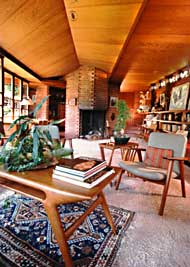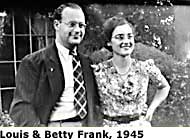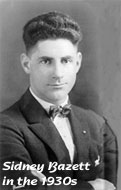The Bazett House - Hillsborough
 If an Eichler hall of fame ever has its day, Betty and Louis Frank will be prime candidates for induction. Until then, they'll at least have our collective appreciation for their role in passing builder Joseph Eichler through the turnstile of golden opportunity.
If an Eichler hall of fame ever has its day, Betty and Louis Frank will be prime candidates for induction. Until then, they'll at least have our collective appreciation for their role in passing builder Joseph Eichler through the turnstile of golden opportunity.
It was the Franks who pointed Eichler in a new direction in the postwar—away from life in the Frank Lloyd Wright-designed Bazett house, and towards recreating the essence of the Bazett experience for himself and others many times over by building 11,000 homes.
If the young Franks had not taken over the pivotal Bazett of Hillsborough back in 1945, serving Eichler, their inherited tenant, with 90-day eviction, history might have followed a very different course. Rather than launching a new career in residential building, Eichler might have stayed put in the Wright Usonian he treasured, eventually slipping into complacency on his way to the top rung of his family's butter-and-egg business—never having to long for paradise lost.

Nearly 55 years have passed since that transition, and Betty Frank is as thrilled today about living in and owning the Bazett house as she was on that first day. "I never could have imagined myself living in such a work of art," she told us recently, her excitement still strong."But this house has always been so perfect for me and my family. It's uplifting, practical, and it moves so beautifully."
Even a perfect fit like the Bazett has its loose ends. Between her praises of a home and lifestyle that she continues to adore, Betty returns her focus to the mystery surrounding her home, and to questions about its original owners that have haunted her for much of the past five decades. As fate would have it, the Franks, in spite of occasional attempts to contact the Bazett family during their first 30 years in Hillsborough, never met Sidney and Louise Bazett, the previous owners.
But throughout the years, the Franks continued to wonder about the whereabouts of the Bazetts, and always wanted to know why, only two short years after building their dream house, the couple walked away from it all. "Every so often I read the correspondence between the Bazetts and Mr. Wright from 1940," Betty said. "They were so excited about the house as it was being built. Everything seemed wonderful, and they were even expecting the stork in May of that year. Then there was a total turnaround, as if something very traumatic had happened. Before long, Mr. Eichler is renting the house—and we hear nothing ever again about the future of Mrs. Bazett."
 The first chapter of the Bazett house story opened in 1938, seven years before the arrival of the Franks. It began with another young couple—Sidney Bazett-Jones, an ambitious businessman based in San Francisco who, in his late 30s, had reached the prestigious position of vice president of Bank of America; and his wife of four years, the former Louise Reno, from a well-known San Mateo family.
The first chapter of the Bazett house story opened in 1938, seven years before the arrival of the Franks. It began with another young couple—Sidney Bazett-Jones, an ambitious businessman based in San Francisco who, in his late 30s, had reached the prestigious position of vice president of Bank of America; and his wife of four years, the former Louise Reno, from a well-known San Mateo family.
The war was on in Europe, but its specter did not discourage the Bazetts from approaching architect Frank LloydWright to design their dream home, albeit of modest proportions, on their own undeveloped property in Hillsborough. Its plan would follow some of the same design features, including the use of hexagonal, honeycomb-like modules, he brought to the Hanna house, his first Usonian in California, built two years earlier on Stanford University.
The planning and negotiations between the Bazetts and Wright, who was at Taliesen, in Spring Green, Wisconsin, was conducted primarily through the mail, and much of that correspondence has survived the years. With well-defined requirements for design, a budget of $7,000, and a seemingly keen appreciation of fine architecture, the couple commissioned the architect in April 1939. "With even our meager artistic knowledge," Sidney Bazett said humbly in that letter to Wright, "it was apparent that it would be a shame to have anyone other than Frank Lloyd Wright design our home."
Jean Hanna, who with husband Paul owned the Hanna house, extended the Bazetts a hand during early planning. While Sidney seemed to find her detailing tedious, the Bazetts agreed with her suggestion to draw up exhaustive lists of design requirements for each of the interior rooms and outside areas, personality traits, and hobbies. Among them were requests for single-story construction, a master bedroom (of three bedrooms in all) that opened onto a porch, no separate dining room, easy access to the outdoors, and a two-car shelter. Opening a small window to their personas, Sidney saw himself as "restless, except when outdoors," with "an excessive amount of energy"; Louise preferred architecture that exuded a "feeling of permanence."




